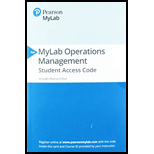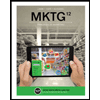
Concept explainers
a)
To determine: Weeks of supply for Company A.
Introduction:
a)
Answer to Problem 6P
Weeks of supply for Company A is 3.85.
Explanation of Solution
Given information:
| Company A | |
| Net revenue | $16,500.00 |
| Cost of sales | $13,500.00 |
| Inventory | $1,000.00 |
| Total assets | $8,600.00 |
Formula to calculate week of supply:
Calculation of week of supply:
Sale per week is calculated by dividing the annual sales with the number of weeks in a year. Annual sales $13,500 is divided with 52 which give $259.60.
Week of supply is calculated by dividing inventory with sales per week. The inventory $1,000 is divided with $259.60 yields 3.85 as weeks of supply for company A.
Hence, weeks of supply for Company A is 3.85.
b)
To determine: Percentage of assets committed to inventory in Company A.
b)
Answer to Problem 6P
Answer: 11.63% of total assets of Company A is committed to inventory.
Explanation of Solution
Given information:
| Company A | |
| Net revenue | $16,500.00 |
| Cost of sales | $13,500.00 |
| Inventory | $1,000.00 |
| Total assets | $8,600.00 |
Formula to inventory investment:
Calculation of inventory investment:
Percentage of assets committed to inventory can be calculated by computing inventory investment. Inventory investment is calculated by dividing inventory with the total assets. The inventory $1,000 is divided with total assets $8,600 which yields 11.63% of assets of Company A is committed to inventory.
Hence, 11.63% of total assets of Company A are committed to inventory.
c)
To determine: Inventory turnover of Company A.
c)
Answer to Problem 6P
The turnover of Company B is 13.5.
Explanation of Solution
Given information:
| Company A | |
| Net revenue | $16,500.00 |
| Cost of sales | $13,500.00 |
| Inventory | $1,000.00 |
| Total assets | $8,600.00 |
Formula to calculate turnover:
Calculation of turnover:
The turnover is calculated by dividing cost of sales with inventory. The cost of sales $13,500 is divided with inventory $1,000 which yields turnover of 13.5 for company A.
Hence, the turnover of Company A is 13.5.
d)
To Compare: Performance of Company A with industry leaders.
d)
Answer to Problem 6P
Company A needs to improve its performance.
Explanation of Solution
Given information:
| Company A | Company B | |
| Net revenue | $16,500.00 | $27,500.00 |
| Cost of sales | $13,500.00 | $21,500.00 |
| Inventory | $1,000.00 | $1,250.00 |
| Total assets | $8,600.00 | $16,600.00 |
Formula:
Comparison calculation of turnover and inventory investment:
| Company A | Company B | |
| Net revenue | $16,500.00 | $27,500.00 |
| Cost of sales | $13,500.00 | $21,500.00 |
| Inventory | $1,000.00 | $1,250.00 |
| Total assets | $8,600.00 | $16,600.00 |
| Turn over | 13.5 | 17.2 |
| Inventory investment | 11.63% | 7.53% |
From the above calculation of turnover and inventory investment it can be inferred that Company A has a turnover of 13.5 when the turnover of Company B is 17.2. The inventory investment of Company A is 11.63% when the Company B has 7.53%.
In both the aspects, Company B is far ahead of Company A. So, the performance of Company A has to be better and the management team must look into the aspects to improve the performance.
Hence, Company A needs to improve its performance.
Want to see more full solutions like this?
Chapter 11 Solutions
EBK PRINCIPLES OF OPERATIONS MANAGEMENT
- Which of the following statements about organization's strategy is FALSE? OA. They are formulated after the organization's mission is determined. OB. They reflect an organization's purpose. OC. An organization's strategy exploits opportunities and threats. OD. They help determine how an organization expects to achieve its miss OE. Each functional area of the organization will have a strategy. The ability of an organization to match changes in a marketplace where design volumes fluctuate substantially is: OA. competing on productivity. OB. mass production. OC. time-based competition. OD. competing on differentiation. O E. competing on response. Porter's Five Forces Model is used to evaluate competition based on which 5 asp A. immediate rivals, potential entrants, customers, suppliers, and substitute B. potential entrants, customers, suppliers, legal regulations, and costarrow_forwardplease answerarrow_forwardplease answerarrow_forward
- please asnwerarrow_forwardWhat are the obstacles to incorporating stress management techniques? How can we overcome these obstacles?arrow_forwardIn the 2016, "ATB: digital disruption in the parking meter industry" perform a finanacial analysis and make a chart similar to this one 2013 2014 Current Ratio 1.88 1.41 Quick Ratio 0.49 0.29 Debt to Equity 0.95 1.92 Return on Assets 5.47% 2.76% Net Profit Margin 2.71% 1.89%arrow_forward
 Purchasing and Supply Chain ManagementOperations ManagementISBN:9781285869681Author:Robert M. Monczka, Robert B. Handfield, Larry C. Giunipero, James L. PattersonPublisher:Cengage Learning
Purchasing and Supply Chain ManagementOperations ManagementISBN:9781285869681Author:Robert M. Monczka, Robert B. Handfield, Larry C. Giunipero, James L. PattersonPublisher:Cengage Learning Contemporary MarketingMarketingISBN:9780357033777Author:Louis E. Boone, David L. KurtzPublisher:Cengage Learning
Contemporary MarketingMarketingISBN:9780357033777Author:Louis E. Boone, David L. KurtzPublisher:Cengage Learning- MarketingMarketingISBN:9780357033791Author:Pride, William MPublisher:South Western Educational Publishing






